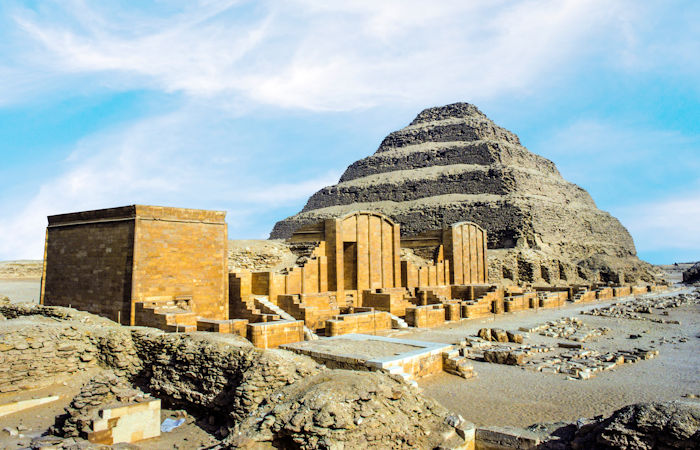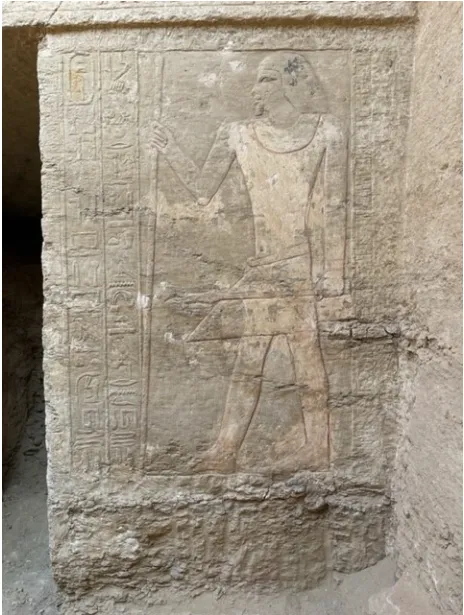A 3,500-year-old Egyptian tomb that belonged to the protector of the Pharaoh’s secret repository was found at Saqqara.

Archaeologists excavating in Saqqara, Egypt have found the tomb of an ancient Egyptian royal clerk who was responsible for the Pharaoh’s secret archive.
The discovery was made by a Polish-Egyptian archaeological team that stated the clerk lived during the reign of Pharaoh Userkare.

Decorations of the chapel of Mehczecziego tomb. Credit: Jarosław Dąbrowski /PCMA
Userkare was the second Pharaoh of ancient Egypt’s 6th dynasty, (2323-2150). His name means “powerful soul.” His rule, from the late 24th century to the early 23rd century B.C is recorded in the Abydos Kings list and there is a damaged space in the Turin list and on the South Saqqara Stone where one might expect to find his reign. Although he is attested in historical sources, Userkare is completely absent from the tomb of the Egyptian officials who lived during his reign. In addition, the Egyptian priest Manetho reports that Userkare’s predecessor Teti was murdered. It has been speculated Userkare may have ordered the assassination of Teti I.
The clerk’s tomb was found in the so-called Dry Moat surrounding the Step Pyramid, the oldest pyramid in Egypt built 4,700 years ago.
Scientists have been able to decipher the hieroglyphs carved on its facade that the tomb belongs to a man named Mehcheczi. “For now, we have only unveiled the facade of the chapel, the interior is waiting for the next excavation campaign. Probably thanks to a good job, Mehczeczi was able to hire an efficient team of craftsmen, because his chapel is decorated with reliefs of exceptional beauty,” Professor Kamil O. Kuraszkiewicz from the Faculty of Oriental Studies at the University of Warsaw said in a press release.
Today the “Dry Moat” is almost entirely covered with rubble and sand blown in from the desert. The region is completely invisible from the earth’s surface, but its outline can be seen in some aerial and satellite photographs.
The last archaeological seasons have brought researchers more new information about this place. Scientists now know that the “Dry Moat” was also used several hundred years after the reign of Pharoh Djoser.
The reliefs on the fascinating ancient tomb clearly suggest clerk Mehczeczi was admitted to the secrets of the Pharaoh’s archive. Professor Kuraszkiewicz emphasizes it is still unknown what privileges and duties Mehczeczi had. It is possible Mehcheczi had the right to know what documents were created at the royal chancellery before they were published, but at this point, it is only a guess as we cannot say anything with certainty, Professor Kuraszkiewicz said.
Although the study of the interior of the chapel and the tomb has not yet begun, archaeologists have obtained a lot of information from reading the facade of the tomb. There are inscriptions and reliefs depicting the owner of the tomb.
As added by Prof. Kuraszkiewicz, unfortunately, the colors have not survived. “But the relief itself reveals an exceptionally skillful hand – elegant lines, subtle modeling – of an artist at least as good as the best of the authors of the reliefs in Merefnebef’s tomb” – he added.
Everything indicates that Mehcheczi lived in the time of Merefnebef, who was a vizier at the court of Pharaoh Userkare. He was the supreme Egyptian dignitary, whose function is comparable to that of today’s prime minister. Merefnebef’s tomb is nearby. It was discovered in 1997 by a team led by Professor Karol Mysliwiec. Merefnebef’s tomb is one of the few in Saqqara with such an exquisitely preserved polychrome.
Professor Kuraszkiewicz described that the decoration was not finished at the entrance to the newly discovered Mehczecziego chapel. Only sketches in black ink on lime plaster are visible. It was on their basis that subsequent craftsmen would later make a bas-relief. They show images of sacrificial animals: cows, oryxes, and ibexes.
The scientist pointed out that the rock on which the decorations were made is very brittle and heavily eroded. This means that the entire substrate, including the painted plaster, required immediate intervention by conservators.

Pyramid of Djoser in the Saqqara necropolis, Egypt. Credit: Adobe Stock – travelview
“For now, we have located the chapel. It is almost certainly the burial shaft in which the owner was buried, but we will find out more after exploring the chapel, as well as whether it was robbed,” Professor Kuraszkiewicz explained.
Near this tomb, there are rooms from the 3rd dynasty (i.e. the times of Djoser) and other burials from the 6th dynasty, consequently contemporary to the one belonging to Mehczeci.
“The new find is therefore not a complete surprise for us. The quality of the reliefs and the name of the owner were certainly a surprise,” Professor Kuraszkiewicz said.
Professor Kuraszkiewicz has been conducting research in the area of ”Sucha Moat” for many years. Scholars suggested that it constituted the boundary between the sphere of the sacred, that is, the royal tomb, and the profane, that is, everything outside of it. According to others, it was a quarry, where the material for the construction of the pyramid was mined, and otherwise, it did not perform any important function.
See also: More Archaeology News
A few years ago, Kuraszkiewicz introduced a new concept. According to him, it could act as a three-dimensional model of the road to the underworld of the deceased Pharaoh.
Future archaeological excavations at the site will provide more information about its function and purpose in the past.